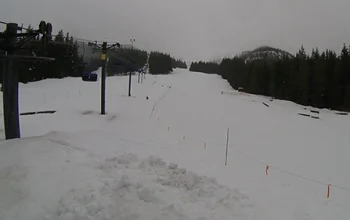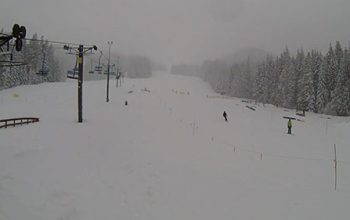

Majestic Views with Mt Hood Live Cams
Mt. Hood is a popular destination for outdoor enthusiasts, and thanks to live cams, you can enjoy the mountain’s beauty from anywhere. One live camera is located in the Mt. Hood Territory, specifically in Government Camp. This camera provides a stunning view of the village and surrounding areas, letting you see snow conditions and weather in real time.
Another live webcam is positioned at Mt. Hood Meadows Ski Resort, offering a bird’s-eye view of the resort’s slopes. Whether you’re planning a trip or just dreaming of the mountain, the live cams offer a glimpse into the action. In addition, these webcams are a great resource for skiers and snowboarders who want to check out snow levels and weather before heading up the mountain. Keep an eye on both cams to stay connected with Mt. Hood, no matter where you are!
Things to Do in the Mt. Hood Area
Mt. Hood is a year-round playground for adventure seekers, nature lovers, and families. Whether you love skiing, hiking, or simply relaxing in a beautiful setting, this area has something for everyone. From thrilling outdoor activities to cozy retreats, here are some of the best things to do in the Mt. Hood area.
1. Ski and Snowboard at Mt. Hood Resorts
Winter transforms Mt. Hood into a paradise for skiers and snowboarders. Three major ski resorts—Mt. Hood Meadows, Timberline Lodge, and Skibowl—offer a variety of slopes for all skill levels. Mt. Hood Meadows is the largest, featuring wide runs and deep powder. Timberline Lodge provides year-round skiing, while Skibowl is famous for its night skiing. If you love winter sports, you won’t want to miss these top destinations. Mt Hood Live Cams offer a live view of camera at Mt Hood Meadows Ski Area.
2. Go Snowshoeing or Cross-Country Skiing
If downhill skiing isn’t your thing, try snowshoeing or cross-country skiing. Trillium Lake and White River Sno-Park are excellent spots for both activities. The peaceful trails and breathtaking mountain views make for an unforgettable experience. Plus, these options are great for all ages and skill levels.
3. Explore Government Camp
Government Camp is a charming mountain village at the base of Mt. Hood. It’s a perfect place to grab a warm drink, shop for gear, or enjoy a meal after a long day on the slopes. You can also visit the Mt. Hood Cultural Center and Museum to learn about the area’s history. Ratskeller is a popular dining option for locals that can be seen on Mt Hood Live Cams.
4. Hike the Stunning Trails
During warmer months, Mt. Hood offers some of the best hiking trails in Oregon. The Timberline Trail circles the entire mountain, providing breathtaking views. Tamanawas Falls Trail is a shorter, family-friendly option that leads to a beautiful waterfall. Another popular hike is Mirror Lake, where you’ll see Mt. Hood’s reflection in the water.
5. Camp Under the Stars
Camping in the Mt. Hood area is a magical experience. Trillium Lake Campground is one of the most scenic spots, offering lakeside views and easy access to hiking trails. Lost Lake Campground is another great choice, with stunning reflections of the mountain on clear days. Spend the night under the stars and wake up to the fresh mountain air.
6. Take a Scenic Drive
If you prefer a relaxing adventure, take a scenic drive around Mt. Hood. The Mt. Hood Scenic Byway offers breathtaking views, winding through forests, rivers, and small towns. Make stops at Timberline Lodge, Trillium Lake, and Hood River for the full experience.
7. Visit Timberline Lodge
Timberline Lodge is a must-see attraction on Mt. Hood. Built in the 1930s, this historic lodge is famous for its rustic charm and stunning architecture. It also served as the exterior for the hotel in The Shining. Inside, you’ll find a cozy fireplace, delicious dining options, and easy access to hiking and skiing.
8. Fish or Paddle on the Lakes
Trillium Lake, Lost Lake, and Clear Lake are perfect spots for fishing, kayaking, and paddleboarding. These peaceful waters provide incredible views of Mt. Hood. Rent a canoe or bring your own gear for a relaxing day on the water.
9. Go Mountain Biking
Mt. Hood’s trails aren’t just for hiking—they’re also great for mountain biking. Timberline Bike Park offers thrilling downhill trails, while Sandy Ridge Trail System provides excellent cross-country routes. Whether you’re a beginner or an expert, there’s a trail for you.
10. Pick Fresh Fruit in Hood River
Just a short drive from Mt. Hood, Hood River is known for its fruit orchards. The Hood River Fruit Loop takes you through charming farms where you can pick apples, pears, and berries. It’s a fun and tasty way to experience the local flavors.
11. Enjoy a Hot Spring Soak
After a long day of adventure, relax in a natural hot spring. Bagby Hot Springs, located in the nearby Mt. Hood National Forest, is a popular spot. Soaking in the warm mineral water is the perfect way to unwind.
12. Try Whitewater Rafting
For thrill-seekers, whitewater rafting on the Clackamas or White Salmon River is a must. These rivers offer exciting rapids surrounded by stunning forest scenery. Guided tours make it easy and safe for beginners.
13. Discover Local Breweries and Wineries
The Mt. Hood area is home to several great breweries and wineries. Mt. Hood Brewing Co. in Government Camp serves excellent craft beer, while Hood River boasts famous wineries like Cathedral Ridge and Wy’East Vineyards. Enjoy a drink while taking in the beautiful mountain views.
14. Go Wildlife Watching
Mt. Hood’s forests are full of wildlife. Keep an eye out for deer, elk, bald eagles, and even black bears. The best places for wildlife spotting include the Mt. Hood National Forest and Tom McCall Preserve.
15. Experience the Magic of Fall Colors
Autumn brings vibrant colors to the Mt. Hood area. Drive through the Columbia River Gorge or hike to Tom Dick and Harry Mountain for the best fall foliage. The golden leaves and crisp air make this season a fantastic time to visit.
A Variety of Activities
No matter the season, the Mt. Hood area offers endless adventures. Whether you’re hitting the slopes, hiking through forests, or relaxing by a lake, there’s always something to do. Plan your trip today and experience the magic of Mt. Hood for yourself!
The History of the Mt. Hood Area
Mt. Hood has a rich history that stretches back thousands of years. From the Indigenous peoples who first called it home to the arrival of European settlers, this mountain has witnessed incredible changes. Today, it remains a beloved landmark in Oregon, but its past tells a story of survival, exploration, and transformation.
The First People of Mt. Hood
Long before European settlers arrived, Indigenous people lived in the Mt. Hood area. The Chinook, Wasco, and Multnomah groups were among the many groups that thrived here. They depended on the land for survival, hunting deer and elk, fishing in the rivers, and gathering berries and roots.
For these groups, Mt. Hood was more than just a mountain—it was sacred. It played a major role in their traditions and stories. One well-known legend tells of a great battle between powerful spirits, which led to the creation of Mt. Hood and the neighboring peaks of Mt. Adams and Mt. St. Helens.
Trade and Travel Along the Columbia River
The Columbia River, located just north of Mt. Hood, served as a vital trade route for Indigenous people. People traveled by canoe to exchange goods such as fish, animal hides, and tools. The Dalles, a narrow stretch of the river, became one of the largest trading centers in North America.
Mt. Hood was also an important landmark for these early travelers. The mountain guided them through the vast forests and helped them navigate the land.
The First Europeans Arrive
In the early 1800s, European explorers and fur traders entered the region. Lewis and Clark passed near Mt. Hood in 1805 during their famous expedition. They recorded the mountain in their journals, calling it a stunning sight.
By the 1820s, fur traders from the Hudson’s Bay Company established forts along the Columbia River. They traded with local groups, exchanging manufactured goods for valuable furs. This contact brought change to Indigenous communities, as new goods and diseases spread through the area.
Naming of Mt. Hood
Before European contact, Indigenous people had their own names for the mountain. However, in 1792, British explorer Lt. William Broughton named it Mt. Hood after Samuel Hood, a British admiral. The name stuck, and it remains today, though many still recognize and respect its Indigenous names.
The Oregon Trail and Early Settlers
By the mid-1800s, thousands of settlers traveled west on the Oregon Trail in search of a better life. Many of them passed through the Mt. Hood area on their way to the fertile lands of the Willamette Valley.
One of the most dangerous sections of the journey was the Barlow Road, built in 1845. This rugged trail allowed settlers to bypass the dangerous Columbia River rapids, but it was still treacherous. Wagons struggled over steep terrain, and many travelers faced hunger, exhaustion, and harsh weather.
Despite the dangers, the promise of land and opportunity kept people moving west. Over time, small communities formed around Mt. Hood, and settlers began logging, farming, and building homes.
The Rise of Timber and Tourism
By the late 1800s, the timber industry began to grow in the Mt. Hood area. Logging companies harvested the region’s massive trees, fueling the economy and bringing more settlers to the area. Railroads soon followed, making it easier to transport goods and people.
At the same time, Mt. Hood became a popular destination for outdoor recreation. Climbers and hikers were drawn to the mountain’s beauty and challenge. In 1894, the first recorded ascent of Mt. Hood by a woman, Fay Fuller, took place, inspiring more adventurers to explore the peak.
Timberline Lodge and the Great Depression
During the Great Depression, the U.S. government launched projects to provide jobs. One of the most famous projects was Timberline Lodge, built in 1937 as part of the Works Progress Administration (WPA). Skilled workers constructed the lodge using local stone and timber, creating a masterpiece of craftsmanship.
Today, Timberline Lodge remains a historic landmark and a popular ski destination.
Modern Mt. Hood
Over the years, Mt. Hood has become a year-round playground for outdoor enthusiasts. Ski resorts, hiking trails, and campgrounds attract visitors from around the world. Despite modern development, the mountain’s deep history remains an important part of its identity.
Many Indigenous people continue to honor their connection to Mt. Hood. In recent years, efforts have been made to recognize their history and protect sacred lands.
Final Thoughts
The history of Mt. Hood is one of resilience and change. From Indigenous group who first lived here to the settlers who shaped its future, the mountain has always played a central role in the region. Today, it stands as a symbol of Oregon’s natural beauty and rich past. Whether you visit for adventure or reflection, Mt. Hood’s story is one worth remembering.
Geography and Topography of the Mt. Hood Area
Mt. Hood is one of the most iconic landmarks in Oregon. This towering peak, part of the Cascade Range, dominates the landscape with its rugged slopes and snow-capped summit. The area surrounding Mt. Hood is just as impressive, featuring deep forests, glacial lakes, and rushing rivers. Its unique geography and topography make it a paradise for outdoor enthusiasts and scientists alike. Mt Hood Live Cams provide fantastic views of this diverse landscape.
A Dormant Stratovolcano
Mt. Hood is a stratovolcano, meaning it was formed by layers of hardened lava and ash. It stands at 11,240 feet, making it the tallest mountain in Oregon and the fourth-highest in the Cascade Range. Though considered dormant, Mt. Hood is still active. Scientists monitor it closely for signs of future eruptions.
The mountain features several glaciers and permanent snowfields. The largest is Eliot Glacier, located on the northeast side. These glaciers feed rivers and streams, providing fresh water to the region.
Forests and Lower Elevations
Surrounding Mt. Hood is the Mt. Hood National Forest, which covers over 1.1 million acres. The lower elevations are densely packed with Douglas fir, western hemlock, and red cedar. These trees provide habitat for diverse wildlife, including elk, black bears, and bald eagles.
In the spring and summer, wildflowers blanket the meadows. Lupine, Indian paintbrush, and beargrass add bursts of color to the landscape.
Rivers and Water Systems
Mt. Hood is the source of several major rivers. The Sandy River, White River, and Hood River all originate from the mountain’s glaciers. These rivers carve deep valleys and create breathtaking waterfalls.
The nearby Columbia River Gorge is another key geographical feature. This massive canyon, located just north of Mt. Hood, was carved by Ice Age floods. It separates Oregon and Washington and provides a stunning contrast to the mountain’s rugged terrain.
Lakes and Volcanic Features
Mt. Hood’s geography includes beautiful lakes formed by past volcanic activity. Trillium Lake and Lost Lake are two of the most popular, offering stunning reflections of the mountain. These lakes were formed by lava flows that blocked natural water paths, creating calm, scenic basins.
Lava fields, hot springs, and old volcanic vents can also be found throughout the region. These features serve as reminders of Mt. Hood’s fiery past.
Final Thoughts
The geography and topography of Mt. Hood make it one of the most fascinating places in the Pacific Northwest. From its towering peak to its deep valleys, this region is a testament to the power of nature.
Climate of Mt. Hood Territory
Mt. Hood Territory experiences a diverse climate due to its changing elevations. The weather varies greatly from the lower foothills to the mountain’s summit. Seasons bring dramatic shifts, making this area a year-round destination for outdoor activities.
Mild and Wet Winters in the Foothills
At lower elevations, winters are cool and wet. Temperatures usually range from 30°F to 50°F. Rain is common, and occasional snowfall occurs. The forests stay green year-round, thanks to the steady moisture.
Heavy Snowfall in the Mountains
Higher up, winters are much harsher. The mountain receives over 400 inches of snow each year. This makes it a paradise for skiers and snowboarders. Blizzards and strong winds often hit the summit, creating extreme conditions.
Warm Summers with Cool Nights
Summers in the foothills are warm, with temperatures between 70°F and 90°F. However, at higher elevations, it remains much cooler. The nights can be crisp, even in July. Wildflowers bloom, and clear skies provide stunning mountain views.
Unpredictable Weather Year-Round
Mt. Hood’s climate can change quickly. Storms roll in fast, bringing sudden rain or snow. Visitors should always check the forecast and be prepared for shifting conditions.


